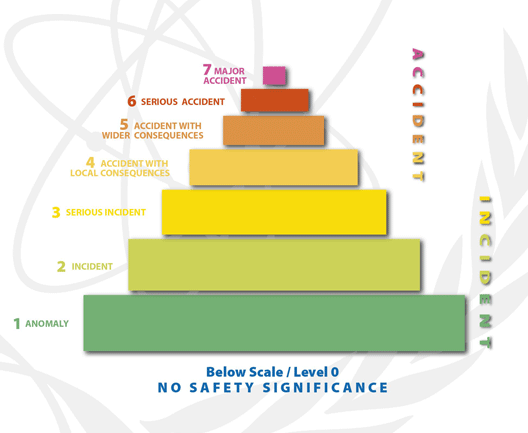by Angie Boyce
Ph.D. student, Cornell University, Department of Science & Technology Studies
Note: This week’s posting schedule starts with a sample educational module. We hope this may inspire and encourage fellow educators to design and share educational modules to help teach about 3/11. We’re posting at a minimum every weekday at 2:46 p.m. local time in Japan for the rest of April. Please stay tuned for new content, and thank you for participating.
 When the Japanese government reclassified the triple disaster from 5 to 7 on the International Nuclear Event Scale (INES) on April 11, 2011, the disaster went from being classified as an “accident with wider consequences” to a “major accident.” Moreover, Fukushima was now placed in the same category as Chernobyl, a move that sparked multiple questions in media discourse: is Fukushima “really as bad” as Chernobyl? Did the Japanese government hide information from the public because it had initially rated the disaster lower on the scale?
When the Japanese government reclassified the triple disaster from 5 to 7 on the International Nuclear Event Scale (INES) on April 11, 2011, the disaster went from being classified as an “accident with wider consequences” to a “major accident.” Moreover, Fukushima was now placed in the same category as Chernobyl, a move that sparked multiple questions in media discourse: is Fukushima “really as bad” as Chernobyl? Did the Japanese government hide information from the public because it had initially rated the disaster lower on the scale?Approaches from the social and historical studies of science and technology tend to ask different kinds of questions about things like the INES. Looking at current public discourse provides a useful starting point, and one such question that can be explored when starting to think about this reclassification critically is: How are different considerations of time and timing playing a role in shaping actors’ opinions on the reclassification?
In this module, have students read the New York Times article entitled, “Japan Raises Severity Level for Fukushima Nuclear Accident,” using the above question first as an initial probe, and second as a prompt to help raise their own questions. Teachers may wish to keep in mind some interesting things that may help guide class discussions: 1) the notion that the level 7 put out too early could cause “panic,” 2) that TEPCO is thinking about the “worst-case scenario,” and 3) that initially, the “margins of error” on computer models of the disaster were too big to justify decision-making. Students should also explore the INES webpage, raising questions about it as well. Thinking questions could include:
- Is the INES similar to the Richter scale or temperature, as the website states?
- Why is the INES user’s manual only available in English, Russian, and Spanish?
- Why doesn’t the INES web page discuss time and timing?
Many of these questions can only be addressed by contextualizing the INES and finding out more about its historical development. One such resource to investigate is a history of the organizational body that created the INES, the International Atomic Energy Agency (IAEA) written by an internal agency historian (see p. 212).
Some separate but related study questions may include: What kind of roles do internal agency historians play? How are public records created and preserved, and who may, should, or can access this information? Do all companies, organizations, or governments have historians, and why or why not?
Sources:
Bradsher, Keith, Hiroko Tabuchi and Andrew Pollack. “Japan Raises Severity Level for Fukushima Nuclear Accident” (Alternate title: “Japanese Officials on Defensive as Nuclear Alert Level Rises”), New York Times, April 12, 2011, accessed April 14, 2011 and April 17, 2011, www.nytimes.com/2011/04/13/world/asia/13japan.html
Fischer, David. 1997. History of the International Atomic Energy Agency: The First Forty Years. International Atomic Energy Agency (Vienna: The Agency), accessed April 14, 2011, http://www-pub.iaea.org/mtcd/publications/pdf/pub1032_web.pdf
The International Atomic Energy Agency.International Atomic Energy Agency website, “International Nuclear Events Scale,” www-ns.iaea.org/tech-areas/emergency/ines.asp, accessed April 14, 2011.
Educational Module: Understanding the International Nuclear Event Scale
![[Teach311 + COVID-19] Collective](https://blogs.ntu.edu.sg/teach311/files/2020/04/Banner.jpg)